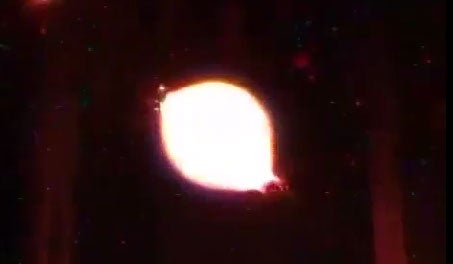Fireballs in space: Amazing video shows Nasa's 'flame extinguishment experiment' in action
Video (below) shows a droplet of liquid fuel ignited in microgravity conditions

Your support helps us to tell the story
From reproductive rights to climate change to Big Tech, The Independent is on the ground when the story is developing. Whether it's investigating the financials of Elon Musk's pro-Trump PAC or producing our latest documentary, 'The A Word', which shines a light on the American women fighting for reproductive rights, we know how important it is to parse out the facts from the messaging.
At such a critical moment in US history, we need reporters on the ground. Your donation allows us to keep sending journalists to speak to both sides of the story.
The Independent is trusted by Americans across the entire political spectrum. And unlike many other quality news outlets, we choose not to lock Americans out of our reporting and analysis with paywalls. We believe quality journalism should be available to everyone, paid for by those who can afford it.
Your support makes all the difference.This is what a fireball looks like in space: first there’s ignition, and then a miniature sun blossoms in mid-air. It flares for a second and then fades away, exiting stage-left in a series of pulse like a ghostly jellyfish.
This amazing footage was captured by astronaut Reid Wiseman and as part of Nasa’s ongoing 'Flame Extinguishment Experiment' - a project dedicated to examining the behaviour of flames in microgravity in order to find better ways to extinguish fires in space.
Wiseman, who is also responsible for the first Vine from space, posted the clip three days ago with the caption - "Forgot to thank @ISS_Research for this amazing video - floating sphere of fire comes alive in FLEX-2.”
The fireball itself was created by igniting a small drop of ethanol or heptane in the microgravity of the ISS. While flames on Earth form vertical shapes thanks to the upward pull of hot air, the lack of gravity in orbit around the planet means that fire naturally becomes dome-shaped or spherical.
Although these flames look tranquil when compared to their flickering, Earth-bound cousins,they're actually much more dangerous - not simply due to their location but also because they survive for longer with less oxygen and are resistant to gas-based extinguishers.
Nasa's research is not only looking for safer ways to put out fires in space, it's also hoping that observations made onboard the ISS will eventually help engineers here on Earth - especially insights into so-called "cool flames" - fires that burn at lower temperatures producing fewer air pollutants.
Join our commenting forum
Join thought-provoking conversations, follow other Independent readers and see their replies
Comments